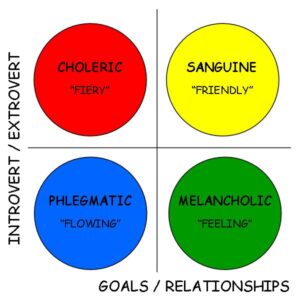Psychologists describe personality types in many different ways, but one of the easiest ways to categorize temperaments was devised by the ancient Greeks.

Your child’s temperament is part of what make’s him or her unique.
On the most basic level, this matrix sorts social preferences and motivations.
Social preferences refer not so much to friendliness and self-confidence as to the source of our inspiration and energy. Extroverts are energized and inspired in a stimulating, active, social environment–one external to themselves. Introverts find energy and inspiration in a quiet, relaxed, reflective environment, often alone or with a very small, intimate circle of trusted friends.
Motivation refers to the primary concern in problem-solving and decision-making. Again I want to emphasize that both goal-oriented and relationship-oriented people may be very friendly and confident, but goal-oriented temperaments tend to keep one eye always on the ultimate goal or purpose of their actions while relationship-oriented temperaments tend to prioritize the way actions affect community.
There is no “right” or “wrong” to temperaments. Each has strengths and weaknesses. Each of us has a unique blend in varying degrees, though one temperament will usually be predominant.
As temperament pertains to learning, understanding your child’s comfort zone, strengths and challenges may help you tailor their learning environment and give them opportunities to shine.
We’ll look at each temperament in more depth in the next posts of this series.



